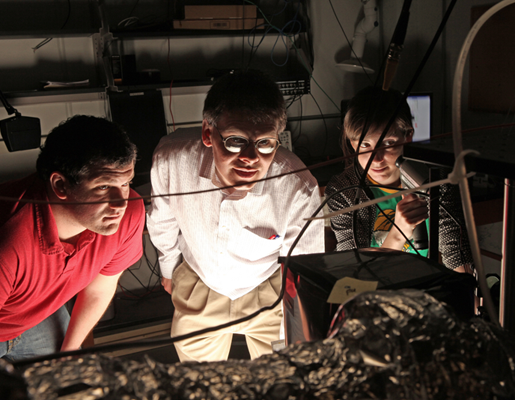They’re cold enough, now
Ultra-chilled rubidium-87 will heat up atomic research
Cold atoms are going to generate hot research at William & Mary.
A small collection of rubidium-87 atoms in Seth Aubin’s Small Hall lab has reached Bose-Einstein condensation after being chilled to a level near absolute zero.
Producing a Bose-Einstein condensate (BEC) is a reason for William & Mary’s physicists to celebrate, but it’s good news for the general public, too. Aubin notes that the science of ultracold atoms can lead to innovations such as atom laser-based interferometers, quantum computing components and ultra-accurate atomic clocks, an essential part of improved GPS and navigation systems.
 The lab confirmed the BEC in mid-September. Five years of
work has gone into the cooling of the atoms to a temperature of around 100
nanokelvin. That’s a hundred billionth of a degree Kelvin, just a bit balmier
than absolute zero. For comparison, water freezes at 273 Kelvin and deep space
is about 3 Kelvin.
The lab confirmed the BEC in mid-September. Five years of
work has gone into the cooling of the atoms to a temperature of around 100
nanokelvin. That’s a hundred billionth of a degree Kelvin, just a bit balmier
than absolute zero. For comparison, water freezes at 273 Kelvin and deep space
is about 3 Kelvin.
At such extreme temperatures, atoms cease behaving like billiard balls, in accordance with Isaac Newton’s laws of motion and, as per the principles of quantum mechanics, take on a wave-like form, explains Aubin, assistant professor of physics at William & Mary.
Atoms in quantum state=high quality control
Physicists use ultracold atoms in the BEC for experiments at the atomic level that otherwise would be impossible. Working with atoms in the quantum state gives researchers a high degree of quality control, Aubin says.
“In the BEC, all the atoms are in exactly the same state,” he explained. “They’re all identical. That’s why they are so useful in experiments. Because they’re all the same, the outcome of your experiments are going to be the same. It’s perfect for controlled conditions.”
The lab is able to produce the BEC reliably, once every 40 seconds or so and maintain the state for a second or a little less—plenty of time for laboratory purposes. “Each individual experiment only lasts a tenth of a second,” Aubin says.
This demonstrated ability to produce BEC reliably and regularly opens a variety of doors. For one, Aubin’s lab can move forward on long-planned experiments to investigate atomic behavior that has remained largely or entirely theoretical. Aubin notes that BEC capability opens new opportunities for funding from federal grant agencies.
“We were in kind of a Catch-22,” he said. “We’d request funding and program officers would say, ‘Well, do you have BEC?’ That’s what we needed the money for!”
Home-built laser cooling system
The lab cools the atoms through a complex laser-driven thermodynamic process. The apparatus is essentially home-built by Aubin, his Ph.D. students Megan Ivory and Austin Ziltz and a cast rotating over the years of perhaps a dozen undergraduates in William & Mary physics department. They received support from the Jeffress Memorial Trust, Virginia Space Grant Consortium and the Army Research Office. The Thywissen research group at the University of Toronto donated an atom chip, the device that holds the BEC in place.
Ivory, assisted by new Ph.D. student Andrew Pyle, will soon begin experiments to simulate a predicted electrical phenomenon known as quantum pumping, using lasers to produce a current of BEC atoms, rather than a current of electrons generated by a voltage source, such as a battery. Ziltz will begin experiments on trapping atoms using radio-frequency magnetic fields. New Ph.D. student Charlie Fancher is working on improving the apparatus to produce larger and faster BECs, using a laser on loan from Old Dominion University.
Aubin says he also expects to starts interferometry
experiments to study the effects of gravity and forces at the atomic level. One
such force is the Casimir-Polder force, which is the cause of attraction
between an atom and any surface near it. A greater understanding of such
phenomena will advance the development of nanotechnology applications, he
noted. ![]()
















